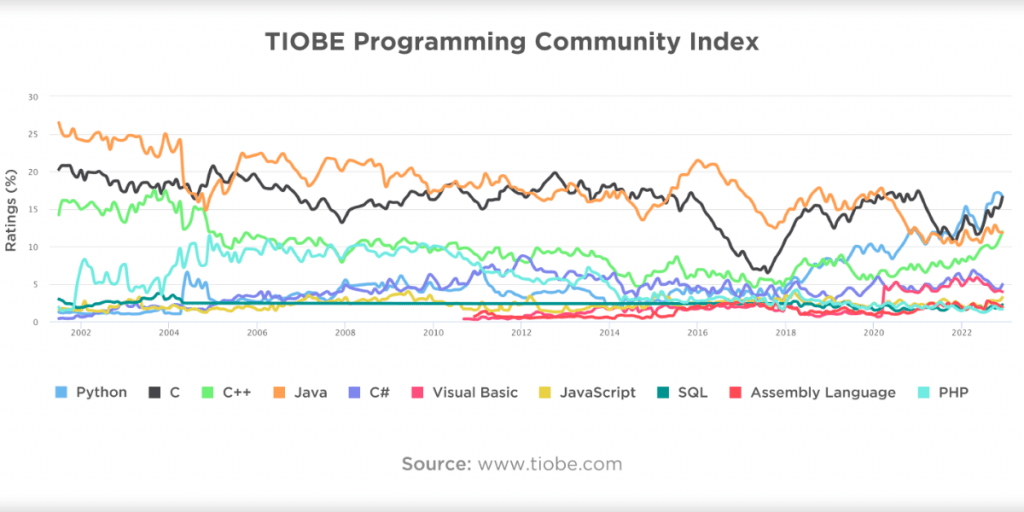Do you know? Global IT spending is expected to increase to around 4.71 trillion U.S. dollars in 2023.
The tech needs of businesses vary on account of their goals and objectives. Execution of different projects within a single business might also differ. The one thing that remains the same often is choosing the right tech stack will save company resources.
Software development is expensive and consequently repairing it is double the cost. It is better to spend more time settling for the right stack than running a business to the ground by choosing the wrong one.
You may also like reading Echoes of Bits: Unheard Sounds in Future Tech
What is a Tech Stack?
The definition of a technology stack usually differs for most people. However, it boils down to one thing; a tech stack is a collection of different software subsystems working together to create a single platform and power an application.
A tech stack can be divided into three parts as explained below:
The Front-end
The front-end layer includes tools required to build a user interface for the end user. In web design, that would be software like JavaScript framework, or for mobile, it might be iOS, Android, or a cross-platform tool like Flutter.
The Back-end
On the other hand, there is the back-end layer, which includes a server-side runtime Node JS or Python along with a database to store user-generated data. In addition, the infrastructure is usually purchased from a big cloud provider, making it favorable to consider the provider part of the tech stack.
The Middle
Now the third and final layer is APIs, which are the tools used to connect the front end to the back end. That might be something like REST or GraphQL that can be used on their own.
In most cases, middleware includes a central third-party service that is needed to run your app, like Stripe for payments, Twilio for text messaging, and SendGrid for emails. These tools often perform tasks that fall into both the back-end and front-end categories. Hence best categorized in the middle.

Popular Tech Stacks
There are many different tech stacks that can be used to develop different types of software applications. Here is a brief overview of some of the most popular tech stacks for different types of applications:
Tech Stacks for Web Applications
- MEAN Stack: The MEAN Stack is a JavaScript-based stack that is popular for developing dynamic web applications. It consists of the following components:
- MERN Stack: The MERN Stack is similar to the MEAN Stack, but it uses React.js instead of AngularJS.
- MongoDB: As described above.
- Express.js: As described above.
- React.js: A JavaScript library for building user interfaces.
- Node.js: As described above.
- LAMP Stack: The LAMP Stack is a popular tech stack for developing web applications on Linux servers. It consists of the following components:
- Linux: An open-source operating system.
- Apache: A widely-used web server software.
- MySQL: A popular relational database system.
- PHP: A server-side scripting language.
- LEMP Stack: The LEMP Stack is an open-source web application stack that is used to develop and deploy dynamic websites and web applications. It consists of the following components:
- Linux: As described above.
- Nginx: (Pronounced “Engine-X”) A web server that can also be used as a reverse proxy.
- MySQL: As described above.
- PHP: As described above.
Tech Stacks for Mobile Applications
- Flutter:
- Dart: The language used in Flutter for creating natively compiled applications.
- Flutter SDK: A UI toolkit for crafting beautiful, natively compiled applications.
- React Native:
- React: A JavaScript library for building user interfaces.
- Native Modules: Components that allow integration with platform-specific code.
- Swift for iOS:
- Swift: A powerful and intuitive programming language for macOS, iOS, watchOS, and tvOS.
- Xcode: The official development environment for iOS.
- Kotlin for Android:
- Kotlin: A modern, expressive, and safe programming language.
- Android Studio: The official IDE for Android development.
Robust Tech Stacks for Data Science and Machine Learning Applications
- Python Stack:
- Python: A versatile programming language.
- Pandas: A library for data manipulation and analysis.
- Scikit-learn: A tool for data mining and data analysis.
- TensorFlow/PyTorch: Libraries for machine learning and deep learning.
- R Stack:
- R: A language and environment for statistical computing.
- Tidyverse: A collection of R packages for data science.
- Shiny: A package for building interactive web apps using R.
Tech Stacks for Enterprise and Other Applications
- Java Stack:
- Java: A widely-used programming language.
- Spring Boot: An easy way to create stand-alone, production-grade Spring-based applications.
- Hibernate: A framework for mapping Java classes to database tables.
- Tomcat: An application server for running Java Servlets and JSPs.
- .NET Stack:
- .NET Core/Framework: A developer platform for building applications.
- ASP.NET Core/MVC: Frameworks for building web apps and services.
- C#: A modern, object-oriented programming language.
- Entity Framework: An ORM framework for .NET applications.
- Ruby on Rails:
- Ruby: A dynamic, open-source programming language.
- Rails: A web application framework written in Ruby.

Choosing the Right Tech Stack
Choosing a good technology stack for your business, especially if it is a startup, is crucial to survival. A poorly chosen tech stack can hinder the scalability and integration of your business which could be hard to fix later.
Let’s look at some of the best tips for choosing the right tech stack;
Cost
When choosing the stack for any project, cost should be an important factor to consider. Have a side-by-side comparison between the cost of development and the benefits of using a particular stack. Cost may not only mean money, it might include time used in development and debugging.
Project Objectives
Depending on the project and the final product in mind, there is a need to look for the most suitable stack. Mobile applications and websites, even though they might interact seamlessly, run on two different frameworks. By understanding this, stack selection will have to differ to suit the demands of the overall project.
Identifying the Needs of the Application
It is crucial to establish the application’s needs. There are components important to power it and that limits the choices made, for instance, machine learning. If you need to have machine learning, not every programming language can execute that.
You might settle for Python. Knowing the major needs of your application will help you start to narrow down the potential options you can choose from.
Team Strengths
Based on the team’s skills, opting for technology combinations that blend with their strength will work best. No single stack works best for all businesses, there is a need to be keen on what the team is good at. Instead of forcing a new framework onto your team, you can lean into what they know while delegating some of the work to a third party. This ensures seamlessness in the workflow.
Future Possibilities
As an organization grows there will be a change in need, similar to increased demand. In addition, programming languages improve over time. To counter the uncertainty of business growth, settling for a stack that has room for improvement is a great choice.
However, you can seek to integrate your stack with new updates and technologies as time goes by. It might be hectic and costly but if it works for the business, the better.
Also read: What is the future of programming?
Available Options
The market is flooded with several frameworks that achieve almost the same outcome. The difference might arise when comparing their overall performance. Do not settle for a tech pack because it is catchy or is being used by a business similar to yours.
These are tools that need to be evaluated. Take time to interact with a few that are available and get to know how well they perform. Some might be popular but they lack the speed and expansive capacity that you might desire.
Technology Strategy
Finally, having a technology strategy will act as a guideline for how the objectives are to be executed. The strategy helps in maintaining the flow of work within the organization and catering to the customer. By setting guidelines, a business can plan on which technologies need to be replaced, updated, or scraped off without affecting operations
In Summary…
When it comes to picking the right technologies that might work for your situation, you can use the above tips to help with the process. The bottom line is there is no single path to follow when coming to a conclusive decision. Each situation is different and it needs to be treated that way for ultimate success.










Leave a Reply